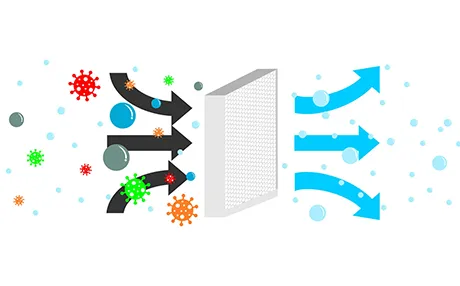If you take any interest to our products
Contact Us >
What is an EPA filter?
EPA-- Efficiency Particulate Air filter. Typically, the filtration efficiency for the most permeable size particles of MPPS is 98.5% or more. (EN1822-2019 E11 or higher)
What is a HEPA filter?
HEPA--High-Efficiency Particulate Air Filter. Typically 99.95% or higher filtration efficiency for MPPS particles (EN1822-2019 H13 or higher)
What is a ULPA filter?
ULPA-- Ultra Low Penetration Air filter. Typically filtration efficiency of 99.9995% or above for MPPS particles (EN1822-2019 U15 or above)
What is a Clean Room?
• A clean environment is designed to reduce process and material contamination by removing or reducing air pollution sources. A cleanroom is a controlled environment in which products are produced. Airborne particle contaminant concentrations in cleanrooms need to be controlled within limits specified by standards.
• The HEPA filter is the key to a clean room and is used to capture air particle pollutants with a diameter of 0.1μm or other tiny particle sizes.
• Each end air supply unit in the clean room must be equipped with HEPA-level high-efficiency filters; some processes with stricter cleanliness levels need to be equipped with ULPA-level ultra-high-efficiency air filters.
• For some key processes or key clean areas, laminar air supply needs to be used to remove air pollutants in the form of laminar flow.
Ideal for critical applications such as semiconductors, pharmaceuticals, food and beverage, and medical facilities, HEPA filters are mechanical air filters that force airflow through a fine mesh to capture harmful particles.

HVAC Air Filter Performance Testing Standard
• IEST-RP-CC001, 007, 021 & 034
IEST American Institute of Environmental Science and Technology, the above standards involve high/ultra-efficient on-site testing of clean rooms, leak testing, filter material selection, etc.;
• EN1822 Parts 1-5
European Standard, Test Methods, and Test Classification for HEPA Filters
• ISO-29463 parts 1-5
International standards, test methods, and test classifications for high-efficiency filters; Written on the basis of EN1822
• ISO-14644
International standards for cleanrooms and related controlled environments, including classification and test methods, etc.
• FDA Guideline for Aseptic Processing
FDA Guidance on Aseptic Process Requirements
EN1822:2019/ISO 29463 (Factory test)
HEPA/ULPA filters need to be scanned and tested before leaving the factory. Each filter needs to be scanned and tested, and an independent test report is issued to prove that the product is qualified and the efficiency meets the requirements. Ensure that the filter has no bypass leakage caused by the structural design, and ensure that the filter has no local leakage caused by the filter element. Factory testing uses a laser particle counter.
ISO 14644-3 (In site/field Testing)
On-site/in-site leak testing is required after the HEPA filter is installed. To ensure that in actual use, the HEPA filter can also provide the required air quality; to ensure the integrity of the seal installed on site, and not to leak contaminants downstream of the HEPA due to improper installation. In situ/field testing employs a photometer or particle counter.
Filter scan test method in clean room site:
Photometer or single-channel particle counter
Scanning test speed: ≤5cm/s
Leaks: Cartridges, Filter Frames, and Matching Cases
The most common leaks occur in:
• Between filter element and frame
• Between filter frame and cabinet
• Connection of filter borders
By continuing to use the site you agree to our privacy policy Terms and Conditions.